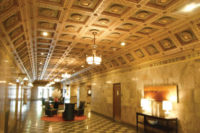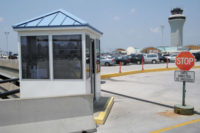NATO meetings. Construction sites. Special events. Corporate shareholder assemblies. Vulnerable assets. Law enforcement assignments. Government facilities. Home builder locations. Emergency street closings.
Whatever the challenge, there is a temporary security solution that can range from hardened barriers, third-party video verification and portable trailers to solar-powered wireless video, light pole surveillance and millimeter wave technology, among others.
Protection can cover very sophisticated and heavy-duty equipment, or it can be as simple as a camera, motion detection package easily setup with a cellular connection and remote monitoring.
At the high end, it’s a niche market, says Lori Flower of Global Access Control Systems, Pittsburgh. The integrator handles a diversity of products and systems and has solid experience with temporary perimeter and traffic controls to create a secure environment. Solutions include a simple barrier arm for minimum security and traffic flow control or a government-rated plate barrier or drop-arm barrier for high security.
Special Event Needs
In this area, much is event related, says Flower. One challenge is that things and requirements can change from hour to hour. So she says it is essential that corporate or government decision-makers work with a solution source that can keep up with those changing needs. There need to be creative ways to solve the problem within a sometimes limited budget. She has had dump trucks and salt trucks donated by local officials to help reinforce a perimeter in addition to barriers.
Flower notes that nothing is a cookie cutter solution. There is the geography of the area being protected on a temporary basis. In situations where governments are involved, there can be numerous municipalities participating, she notes, advising that securing installations and streets on a temporary basis calls for advisors with deep experience.
There are numerous examples of the successful application of high-security temporary barriers.
For example, mobile deployable vehicle crash barriers from Delta Scientific helped police and military officers protect the President, Congressional leaders, judges, journalists, other attendees and onlookers at the latest Presidential Inauguration events. The aim was protection from a vehicle bomb attack and errant drivers. These mobile deployable vehicle crash barriers carry a rating to stop 7.5 ton vehicles traveling 40 mph.
Street Barriers Used
In Washington, D.C., the totally self-contained barriers were towed into position and began controlling vehicle access within 15 minutes. No excavation or sub-surface preparation was required. Once positioned, the mobile barricades unpacked themselves by using hydraulics to raise and lower the barriers off their wheels. DC-powered pumps then raised or lowered the barriers. Such mobile crash barriers were also used for such special events as the Republican and Democratic Presidential Nominating conventions.
In similar situations, deployable barriers helped international government officials, police and military officers protect heads of state and other global leaders, more than 2,000 journalists, attendees and onlookers at the Chicago NATO (North Atlantic Treaty Organization) Summit and the Pittsburgh G-20 Summit.
Beyond metal muscle solutions, specialized video event management systems can be packaged with mobile trailers for temporary installation at facilities and properties to provide protection as well as a forensics method of identifying and successfully prosecuting intruders and vandals.
It’s a technology advance beyond sticking a camera on a pole, says Steve Birkmeier, vice president at Arteco, and which provides its technology to partners and corporations who integrate it into their mobile trailers and vehicles used usually during a short period of time for security and surveillance. The goal, according to Birkmeier, is real-time notification and recording of incidents through such strategies as smart fences, video analytics, mapping interfaces and other tech twists.
Multiple Applications
These trailers are used for many different applications including construction, special events, law enforcement and parking lots, to name a few. Arteco provides partners such as Wanco of Arvada, California, with industrial hardware such as network video recorders as well as video event management software for their application.
Another temporary installation security solution: microwave barriers. This type of battery-powered device develops an electromagnetic beam using high frequency microwaves that pass from a transmitter to a receiver, creating an invisible but sensitive protection wall around an entrance, assets or a selected area. When the receiver detects a difference of condition within its beam (a possible intrusion), the system begins a detailed analysis of the situation that, if considered a real intrusion, provides an alarm signal that can be treated in analog or digital form. Birkmeier works with CIAS of Chesterfield, Missouri, to further enhance microwave barriers with additional software for temporary perimeter protection with cameras and analytics, depending on end user needs.
Diverse Communications
Communications in such designs can be landline, 4G cellular, satellite or other wireless means. But, says Birkmeier, it is best to go with a software and video source with a lot of trailer experience.
When it comes to temporary solutions for security of installations, assets or property, there are more typical technology answers that do not necessarily involve barriers, trailers or vehicle-mounted gear.
“Technology here is getting better, mimicking permanent security installations,” says Andre Brown with Cerami & Associates of New York City, a building technology consultancy. “From a surveillance standpoint, there are all-in-one cameras with motion detection and analytics, cloud-based systems and solar power, too,” Brown observes. Infrared cameras now can get great images at night, he adds.
Remote interactive video surveillance can be easily added or moved to new locations to reduce or eliminate onsite guard services. Such an approach can include digital remote cameras, third-party remote monitoring, software analytics and perimeter intrusion technology. According to Rush McCloy of Eyewitness Surveillance, solid first step for an enterprise is to understand where the most vulnerable assets are. Each site can be very different. Map out the environment, especially entry and egress points.
McCloy adds that, even in temporary protection solutions, lighting is important while considering the space to be protected as well as the distance to cameras, which can range from typical security cameras, thermal cameras and high definition to cameras with IR illumination.
Moveable Security
Kevin O’Shea, divisional president for Ottawa, Canada-based Mattamy Homes, uses IP cameras to monitor home building locations and rotates the technology as home clusters are finished. The Internet-connected IP cameras stream real-time, high resolution video over the Internet. O’Shea can watch live video as it happens to check up on home construction, progress, suppliers and workers as well as counter shrinkage, using a standard networked computer.
Mattamy Homes is one of the largest privately owned builders in North America and is Canada’s largest new home builder, with operations across Canada and the United States. “It’s a matter of containing shrinkage. Materials on a site might go missing. We also monitor behavior for health and safety issues,” says O’Shea. Finance and insurance all like the cost control video solution.
Archived video is stored locally, points out Hugh Wong, chief operating officer with UCIT Online Security. Adds O’Shea: “There is signage on sites saying you will be photographed and we provide a building orientation for subcontractors and trades partners. It has changed the way we do our business and matches our business commitment.”
As construction at home clusters finishes, the solution moves to the next site. “This project is in phases and sight lines of the cameras are redesigned for the next location,” says Wong.
Another example of smart use of technology to protect temporary special events is at the University of California, San Diego (UCSD), a public research university in La Jolla, California.
University Special Event
Of course, it already has a traditional security video installation. UCSD’s existing surveillance system manages about 1,000 channels of video, including a mix of IP cameras (75 percent) and legacy analog cameras (25 percent). They view university centers, provide campus overviews and operate alongside 12 mass notification system towers. Cameras also view animal research facilities, which can be targets for protests. A robust video management system is integrated into the campus police dispatch center and two other video monitoring centers.
Even with the extensive surveillance system, however, there were locations previously beyond the view of campus police, especially remote locations outside the reach of the campus network or existing power supplies. Campus police also wanted additional video views of special events, specifically the Sun God Festival, a 10-hour spring concert event with 25,000 attendees held in and around an athletic field beyond the boundaries of traditional surveillance.
Gary Matthews, UCSD’s vice chancellor for resource management and planning, saw value in a wireless surveillance solution because of the environmental and sustainability advantages related to its use of solar power. The surveillance solution also doesn’t require trenching to provide power or network connectivity to a camera in a remote location, so the installation doesn’t impact the environment. The self-contained system uses solar power and connects wirelessly to a central video hub that ties into the network.
The UCSD Police Department evaluated the technology and decided to implement a trial installation to provide additional surveillance of the Sun God Festival. San Diego integrator Layer3 Security Services installed three solar, wireless cameras to capture views of the large open area where the festival is held. Surveillance helps to manage vehicle traffic and crowds for short term event monitoring.
“The solution provides us additional flexibility during temporary events. During the Sun God Festival, event production managers and staff could view the flow of pedestrian traffic, which enabled them to manage the event and adjust staff as needed,” comments Roberto Meza, USCD campus security coordinator.
On a Light Pole
Cameras were installed on a single light pole to view various sections of the festival site. The system also included three separate solar panels (in addition to the solar panels that are part of the camera housing) and three wireless antennas to send signals to the system video hub located in line-of-sight and directly across the field in an annex building. Each element of the system was positioned to optimize views of the surrounding areas; solar panels to maximize exposure to the sun; and the wireless antennas to provide optimal signal transmission. Layer3 mounted the elements for all three cameras on a large 18-inch diameter light pole using metal bands and a substructure of galvanized pipe to support the various components.
The cameras use existing lighting and automatically switch to low light mode as necessary to continue providing clear views. “The cameras increase our ability to meet the needs of specific events,” says Roberto Meza, campus security services coordinator for UCSD police department.
In Wilkes-Barre, Pennsylvania, another unique installation uses millimeter wave technology to transit video from the police department parking garage.
Tiny, interference-free Gigabit radios help provide seamless monitoring from cameras. Ricardo Turcios, operations manager for Precision Integrators, understood that the ideal solution for securing the parking decks would need to be license-free, and also have a narrow beam-width to enable link collocation and interference mitigation.
The selected parking garages were upgraded to 4K cameras as these are much more bandwidth-intensive than their predecessors. The northern garage previously used a 5GHz system to backhaul the video to the control center and results were marginal at best. With the new link using the asymmetric function, 750Mbps is delivered from the garage to the archiver and a 250Mbps connection to the cameras enable ultra-fast, reliable viewing for investigatory purposes.
The millimeter wave approach can work well in other temporary security situations, too.






